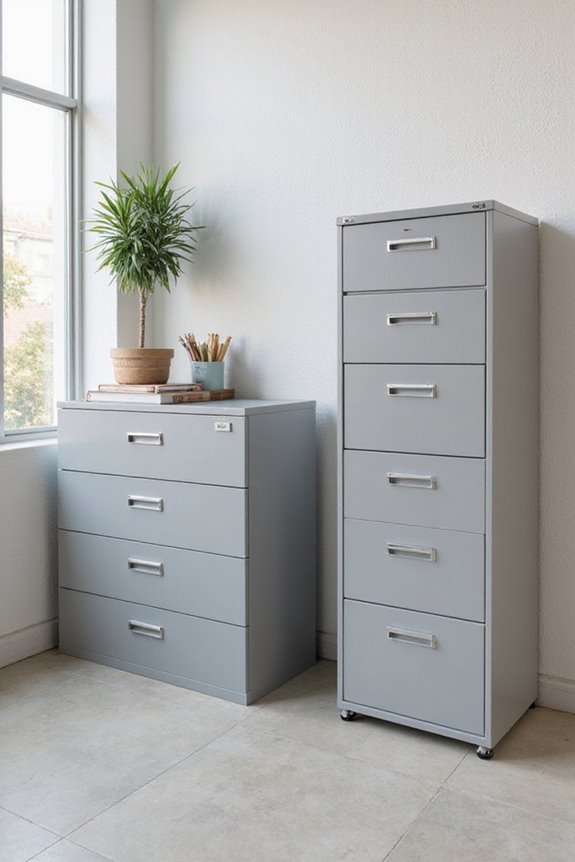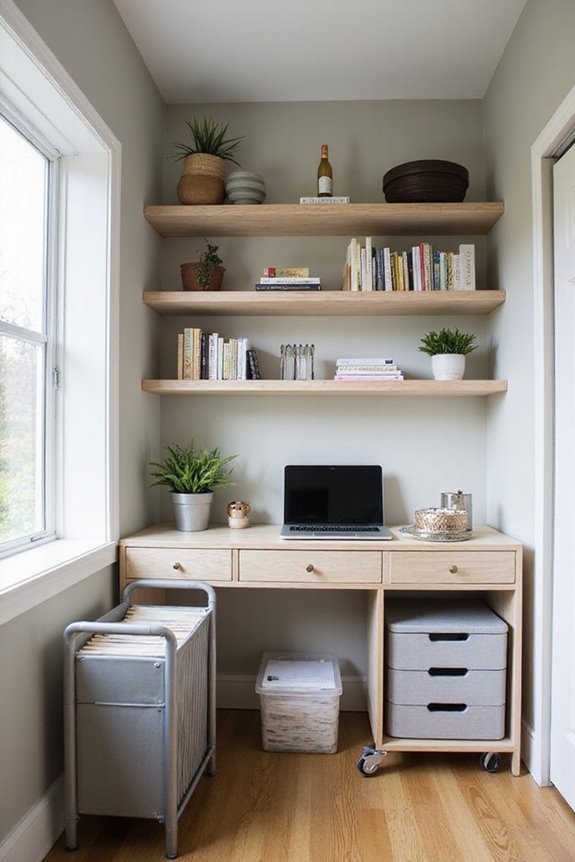When choosing between lateral and vertical filing cabinets, start with your space requirements. Vertical cabinets are compact and fit well in smaller areas, while lateral cabinets require more floor space but offer greater accessibility. Consider your filing needs; lateral cabinets are better for collaborative environments due to their easy access. Finally, assess your budget—vertical options are generally more affordable. By evaluating these factors, you’ll find the best solution for your workspace needs. Additional insights await you on this topic.
Key Takeaways
- Assess your space: choose vertical cabinets for compact areas and lateral cabinets for larger, collaborative environments needing more accessibility.
- Consider filing needs: vertical cabinets suit personal workspaces with lighter filing, while lateral cabinets are ideal for high-traffic areas requiring frequent access.
- Evaluate organization: lateral cabinets allow for better visibility and easy access to files, while vertical cabinets might hinder retrieval speed due to deep drawers.
- Review budget: vertical cabinets are generally more affordable, with entry-level options under $100, whereas lateral cabinets start around $300.
- Think about document sizes: lateral cabinets efficiently accommodate both letter and legal-sized documents, while vertical cabinets may have size limitations.
Space Considerations
When you’re evaluating filing cabinets for your office, it’s essential to take into account the available space and how you’ll use it. If you’re in a smaller area, vertical cabinets offer distinct advantages. Their compact design allows them to fit flush against walls, making efficient use of wall space without occupying much floor area. However, they do hold fewer files per drawer, making them suitable for light to moderate filing needs.
On the other hand, lateral cabinets provide significant benefits in larger or shared spaces. Their wide drawers offer greater accessibility and higher overall storage capacity. While they require more floor space, they allow for easier file retrieval and can serve as additional work surfaces, enhancing collaborative environments.
File Organization
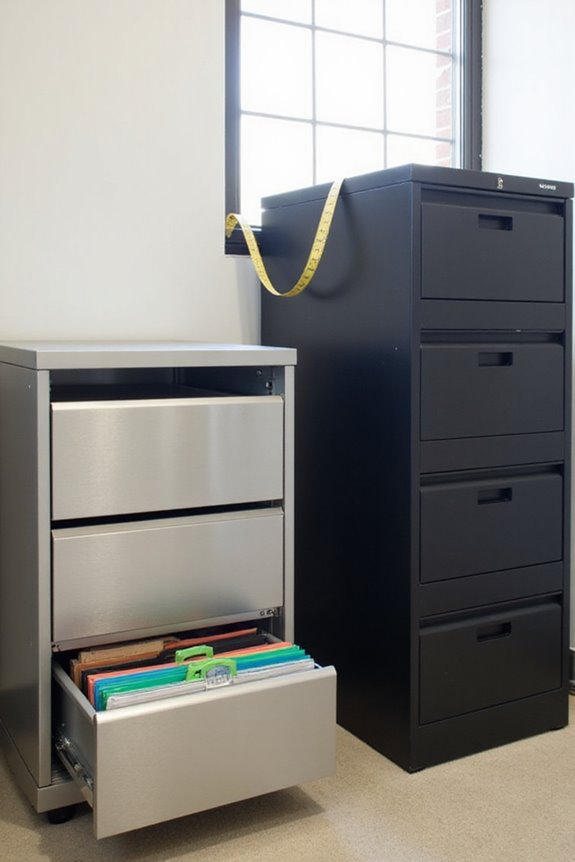
Effective file organization is essential for maintaining efficiency in any office environment. By employing various file organization techniques, I can tailor the system to my specific needs. For instance, sequential file organization allows easy additions and deletions, while indexed sequential files offer quick access to specific records. Tree structures are great for handling complex data relationships, making queries more manageable.
The benefits of effective file organization are clear: it enhances efficiency, flexibility, and scalability. With a well-organized system, I can simplify data updates and maintain integrity, ensuring smooth operations. Choosing the right filing cabinet can further support these techniques, helping me create an organized workspace that optimizes my productivity and meets my organizational demands.
Access and Retrieval

Choosing the right filing cabinet directly impacts how quickly and easily I can access and retrieve files. In my experience, vertical cabinets can be less efficient for retrieval speed due to their deep, front-to-back drawers. I often find myself sifting through files stacked behind each other, making it harder to achieve good file visibility. On the other hand, lateral cabinets offer wide, side-to-side drawers that allow for all file labels to be visible at once. This design not only enhances file visibility but also considerably improves retrieval speed, particularly in busy environments. For collaborative spaces, lateral cabinets are ideal, as multiple users can access files simultaneously without the hassle of bending or reaching.
Cost and Budget
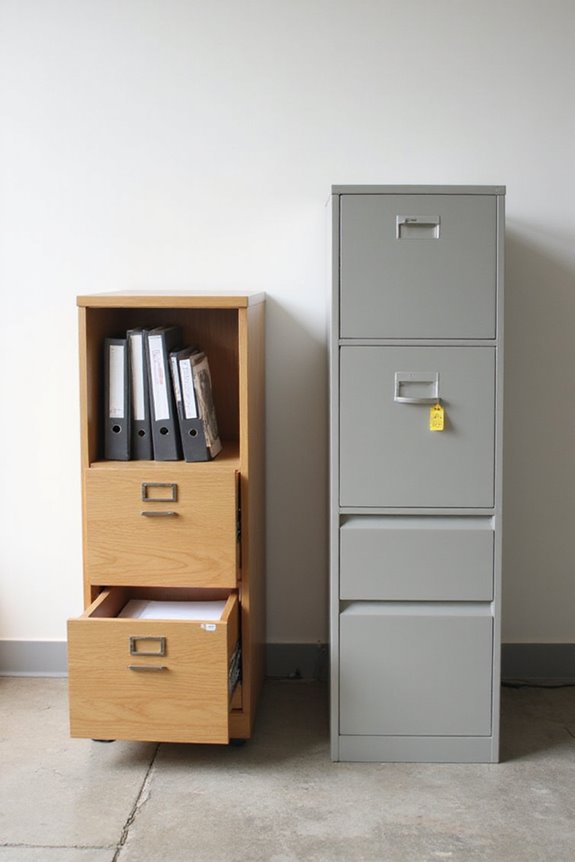
Understanding the cost implications of filing cabinets is essential, especially if you’re working within a tight budget. When considering cost effectiveness, vertical cabinets often emerge as the more affordable option. Entry-level vertical models typically cost under $100, while mid-range options range from $100 to $500. In contrast, lateral cabinets start above $100, with standard models between $300 and $1,000. For those facing budget constraints, vertical cabinets provide greater storage capacity per dollar spent. Additionally, used vertical cabinets are widely available and less expensive. While lateral cabinets may offer long-term value for high-capacity needs, the initial lower costs of vertical cabinets make them a favorable choice for small offices or startups aiming to minimize expenses.
Usage Scenarios
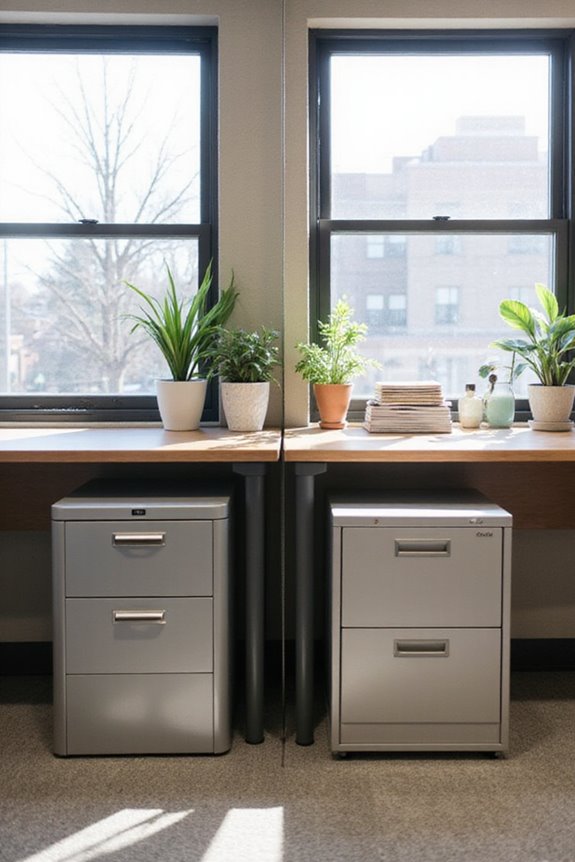
How do you determine which filing cabinet is best for your specific needs? In various office environments, your choice often hinges on specific usage scenarios. If you’re in a smaller or more confined space, vertical cabinets are ideal as they take up less wall footprint while fitting snugly in tight corners. However, if your workspace is open and requires frequent access to files, lateral cabinets shine due to their quick retrieval and broader access. Additionally, if you handle both letter and legal-sized documents, lateral cabinets can accommodate both types efficiently. For environments with high traffic, lateral systems enhance productivity, while vertical cabinets suit personal workspaces with lower filing needs. Ultimately, consider your space and document management frequency.
Frequently Asked Questions
What Are the Weight Limits for Lateral and Vertical Filing Cabinets?
When considering weight limits, I’ve found vertical cabinets typically support 45–60 pounds per drawer, while lateral ones manage 30–70 pounds. Ensuring cabinet stability is essential; exceeding these limits can lead to serious issues.
How Can I Improve the Security of My Filing Cabinets?
To improve my filing cabinet security, I’ve focused on strong lock mechanisms and fire resistance features. Regularly checking locks and ensuring cabinets are fire-resistant gives me peace of mind about my sensitive documents’ safety.
Are There Eco-Friendly Options for Filing Cabinets Available?
When it comes to eco-friendly filing cabinets, I’ve found a treasure trove of sustainable materials and innovative recycled options. They not only help the planet but also add a unique charm to my workspace.
What Materials Are Commonly Used in Filing Cabinets?
When I think about filing cabinets, I notice they often feature metal types like galvanized steel, or beautiful wood finishes. Each material has its benefits, balancing durability and aesthetics, depending on what I need for my space.
How Can I Maintain My Filing Cabinets for Longevity?
To maintain my filing cabinets for longevity, I use regular cleaning techniques and focus on drawer organization. Weekly wipe-downs and annual decluttering keep everything in order, ensuring smooth operation and preventing unnecessary wear.

